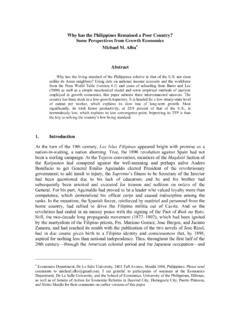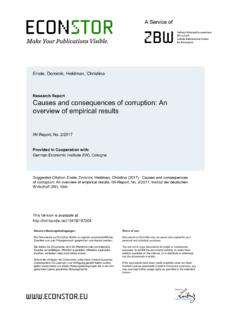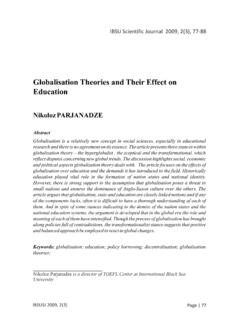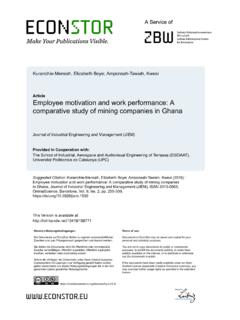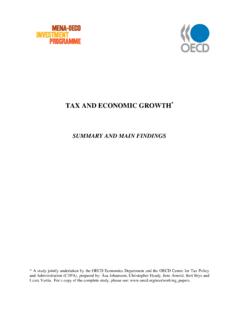Transcription of THE RELATIONSHIP BETWEEN SAVINGS AND ECONOMIC …
1 17 THE RELATIONSHIP BETWEEN SAVINGS AND ECONOMIC GROWTH IN countries WITH DIFFERENT LEVEL OF ECONOMIC DEVELOPMENT Piotr Misztal1 Abstract The aim of this paper is to analyze the cause and effect RELATIONSHIP BETWEEN ECONOMIC growth and SAVINGS in advanced economies and in emerging and developing countries2. In this work we used the method based on studies in macroeconomics and international finance as well as econometric methods (co-integration models and Granger s causality test). All statistical data used in this paper came from the International Monetary Fund database (World ECONOMIC Outlook database).
2 The results confirmed the existence of one-way casual RELATIONSHIP BETWEEN gross domestic SAVINGS and gross domestic product in the case of developed countries as well as in developing and transition countries . At the same time it was revealed the absence of causal RELATIONSHIP BETWEEN gross domestic product and gross domestic SAVINGS both in developed economies and developing and transition countries . JEL classification: D91, E21 Key words: SAVINGS , ECONOMIC growth, co-integration Received: Accepted: Introduction A quick review of literature on the RELATIONSHIP BETWEEN SAVINGS and ECONOMIC growth indicates a positive RELATIONSHIP BETWEEN domestic SAVINGS and ECONOMIC growth.
3 This positive RELATIONSHIP can be explained with several hypotheses. The first one assumes that increased SAVINGS may stimulate ECONOMIC growth through increased investment (Bebczuk 2000). This approach is supported by Harrod (1939), Domar (1946) and Solow (1956) growth models. Also results of empirical research by Alguacil, Cuadros and Orts (2004) as well as by Singh (2009) provide support for the hypothesis that increased SAVINGS promote ECONOMIC growth. The theories of ECONOMIC growth stipulate that the dynamics of the country s ECONOMIC growth increases if the investment in human or material capital or in scientific research and development (R&D) grows.
4 However, if the country has access to international financial markets, it may not necessarily develop faster due to domestic SAVINGS , as investment may be financed with foreign SAVINGS (Guterries, Solimano, 2007). 1 Dr Piotr Misztal, Technical University of Radom, Department of Economics, Chair of International ECONOMIC Relations and ECONOMIC Integration, ul. Chrobrego 31, 26-600 Radom, 2 In World Bank and International Monetary Fund papers, the group of economically developed countries is called advanced economies. The group of developing countries , on the other hand, is known as developing economies, while since 2004 they have been defined as emerging markets and developing countries .
5 The first group of countries includes 34 economies, while the second group includes 150 countries . Due to the limited availability of statistics on various countries , the study was based on available statistical data on average rates of saving and ECONOMIC growth in developed countries , as well as in emerging and developing countries . 18 The second hypothesis, on the other hand, has it that ECONOMIC growth stimulates increased SAVINGS . This approach is backed up by the Keynes model (1936). Moreover, the results of empirical research carried out by Sinh and Sinh (1998), Saltz (1999), Agrawal (2001), Anoruo and Ahmad (2001), Narayan and Narayan (2006) and Abu (2010) confirm this hypothesis.
6 ECONOMIC growth and domestic SAVINGS in view of the empirical analyses results ECONOMIC literature usually analyzes the RELATIONSHIP BETWEEN ECONOMIC growth and SAVINGS using the correlation coefficient and dynamic econometric models. Bacha (1990), Otani and Villanueva (1990), DeGregorio (1992), Jappelli and Pagano (1994) in order to analyze the relationships BETWEEN SAVINGS and ECONOMIC growth used the ordinary least squares method (OLS). Their research proved that the higher the domestic SAVINGS rate (share of domestic SAVINGS in GDP), the higher the ECONOMIC growth rate. Also research carried out by Krieckhaus (2002) in 32 countries indicates that higher level of domestic SAVINGS led to higher investment levels and thus contributed to higher rate of ECONOMIC growth in analyzed countries .
7 Recently a lot of research on RELATIONSHIP BETWEEN SAVINGS and ECONOMIC growth has used the concept of the Granger causal RELATIONSHIP . Caroll and Weil (1994), basing on the data of five-year average rates of ECONOMIC growth in OECD member states and using Granger causality test came to the conclusion that the rate of ECONOMIC growth was the cause of SAVINGS in Granger sense. However, Attanasio, Picci and Scorcu (2000) questioned the reliability of the results obtained by Caroll and Weil (1994), implying that the use of annual data instead of average data from five years improves the precision and statistical importance of estimates and changes the structure of the causal RELATIONSHIP BETWEEN variables.
8 Mohan (2006), using the Granger causality test, analyzed the RELATIONSHIP BETWEEN ECONOMIC growth and SAVINGS in four groups of countries with various levels of ECONOMIC development in the 1960-2001 period. The results of this research turned out to be ambiguous and revealed that in 13 of the analyzed countries ECONOMIC growth was the cause of increased SAVINGS in Granger sense. The opposite results, pointing at SAVINGS being the cause of ECONOMIC growth, were obtained in two countries . Also in other two countries no causal RELATIONSHIP BETWEEN SAVINGS and ECONOMIC growth was observed. In five countries , however, the scientist confirmed the existence of a two-way RELATIONSHIP BETWEEN ECONOMIC growth and SAVINGS .
9 We can also observe the growing importance of the research on the RELATIONSHIP BETWEEN SAVINGS and ECONOMIC growth using the co-integration techniques. Katircioglu and Naraliyeva (2006) analyzed the relationships BETWEEN domestic SAVINGS , direct foreign investment and ECONOMIC growth in Kazakhstan in the 1993-2002 period using the Granger causality test and co-integration methods. The results of their research pointed at the existence of one-way, positive relation BETWEEN domestic SAVINGS and ECONOMIC growth in Kazakhstan in a long period of time. Saltz (1999) using the model of vector error correction (VEC) and the model of vector auto regression (VAR) analyzed the relation BETWEEN SAVINGS and ECONOMIC growth in seventeen countries from all over the world.
10 The results of the analysis indicated that in nine of the analyzed countries ECONOMIC growth was the cause of increased domestic SAVINGS . In two countries the opposite relation was noticed, while in three other countries no causal relation BETWEEN ECONOMIC growth and domestic SAVINGS was identified. Finally, in two countries , the existence of a two-way causal relation BETWEEN analyzed variables was confirmed. Also Baharumshah, Thanoon and Rashid (2003) examined the relation BETWEEN ECONOMIC growth and SAVINGS in five Asian countries (Singapore, South Korea, Malaysia, Thailand and 19 Philippines).
